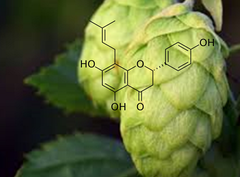6- and 8-Prenylnaringenin, Novel Natural Histone Deacetylase Inhibitors Found in Hops, Exert Antitumor Activity on Melanoma Cells [11.12.18]
Originalpublikation
Venturelli, Sascha; Niessner, Heike; Sinnberg, Tobias; Berger, Alexander; Burkard, Markus; Urmann, Corinna et al.: 6- and 8-Prenylnaringenin, Novel Natural Histone Deacetylase Inhibitors Found in Hops, Exert Antitumor Activity on Melanoma Cells. Online verfügbar unter https://www.karger.com/Article/FullText/495275.
Autor Informationen:
- Institute of Physiology, Department of Vegetative and Clinical Physiology, University of Tuebingen, Tuebingen, Germany
- Division of Dermato-Oncology, Department of Dermatology and Allergology, University of Tuebingen, Liebermeisterstrasse 25, Tuebingen, 72076, Germany
- Hochschule Weihenstephan-Triesdorf, TUM Campus Straubing, Division of Organic and Analytic Chemistry, Straubing, Germany
- Department of Physiology, Technical University of Munich, Munich, Germany
- Evotec AG, Hamburg, Germany
- Institute of Biological Chemistry and Nutrition, University of Hohenheim, Stuttgart, Germany
- Department of Internal Medicine VIII, University Hospital Tuebingen, Tuebingen, Germany
- German Cancer Consortium (DKTK), DKFZ Partner Site Tuebingen, Tuebingen, Germany
Abstract
Background/Aims: Prenylnaringenins are natural prenylflavonoids with anticancer properties. However, the underlying mechanisms have not been elucidated yet. Here we report a novel mode of action of 6- and 8-prenylnaringenin (PN) on human melanoma cells: Inhibition of cellular histone deacetylases (HDACs). Methods: We performed in silico and in vitro analyses using 6-PN or 8-PN to study a possible interaction of 6-PN or 8-PN with HDAC as well as Western blot and FACS analyses, real-time cell proliferation and cell viability assays to assess the impact of 6-PN and 8-PN on human metastatic melanoma cells. Results: In silico, 6-PN and 8-PN fit into the binding pocket of HDAC2, 4, 7 and 8, binding to the zinc ion of their catalytic center that is essential for enzymatic activity. In vitro, 100 μmol/L of 6-PN or 8-PN inhibited all 11 conserved human HDAC of class I, II and IV. In clinical oncology HDAC inhibitors are currently investigated as new anticancer compounds. In line, treatment of SK-MEL-28 cells with 6-PN or 8-PN induced a hyperacetylation of histone complex H3 within 2 h. Further, 6-PN or 8-PN mediated a prominent, dose-dependent reduction of cellular proliferation and viability of SK-MEL-28 and BLM melanoma cells. This effect was apoptosis-independent and accompanied by down-regulation of mTOR-specific pS6 protein via pERK/pP90 in SK-MEL-28 cells. Conclusion: The identification of a broad inhibitory capacity of 6-PN and 8-PN for HDAC enzymes with antiproliferative effects on melanoma cells opens the perspective for clinical application as novel anti-melanoma drugs and the usage as innovative lead structures for chemical modification to enhance pharmacology or inhibitory activities. © 2018 The Author(s). Published by S. Karger AG, Basel.


